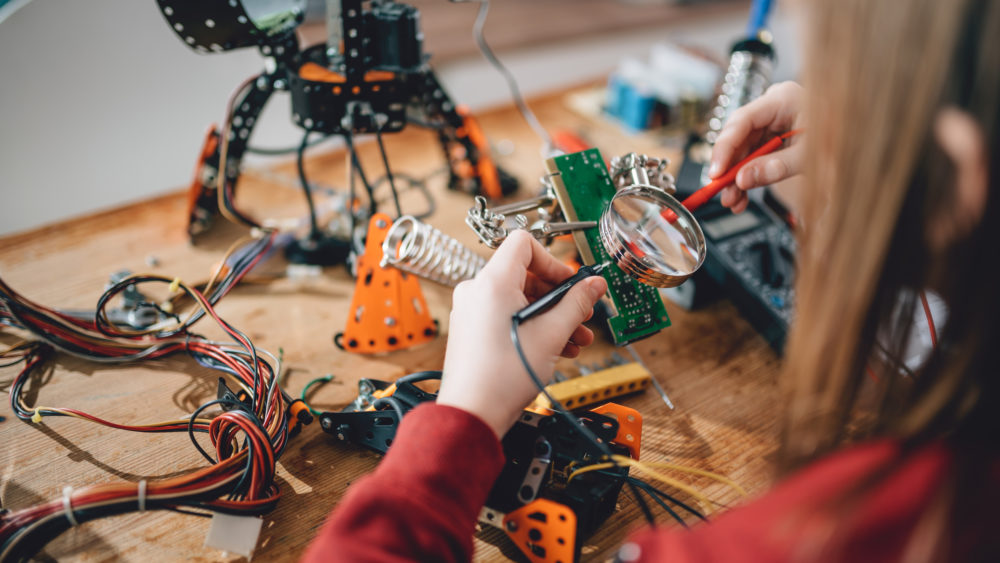When children are still in primary school it can seem a little too early to be thinking about their careers. But the skills, passions, and knowledge they pick up in their early years can be incredibly important.
As the workplace changes, STEM (science, technology, engineering and maths) skills are becoming more in demand. In fact, research looking at the highest paying graduate jobs find degrees in STEM subjects dominate the list. Even if children choose not to follow a STEM career, the skills picked up can be invaluable for other roles, from problem-solving to creative thinking.
If you want to encourage a passion for learning and the development of STEM skills in children or grandchildren, here are seven tips that can help.
1. Encourage their natural curiosity
The good news is that children are naturally curious and ask questions about the way things work. Encouraging this can help improve their cognitive skills and the way they tackle problems.
At times you’ve no doubt been asked why things work or are a certain way. Taking the time to answer their questions can help sate their curiosity. Don’t be afraid to admit you don’t know something either. Looking it up together, whether in a book, online or by watching a TV show, is just as valuable and provides an opportunity to teach research skills too.
2. Teach them to improve
While answering their questions is important, asking them is just as essential.
Prompting them to think and explore other options can lead to plenty of new learning opportunities and encourage them to think creatively. For example, ask how they’d improve the design of their favourite toy. Do they have ideas for how a toy car could be made to go faster?
It’s a method that can help them start thinking like an engineer, rather than finding a single solution or accepting how things are, they look for where improvements can be made. This gives you a chance to get them collaborating and learning from others too by encouraging them to discuss ideas with other adults, siblings, or friends.
3. Provide opportunities for creative play
While STEM involves thinking logically about problems, creative thinking is also essential.
Most toys encourage children to engage with their imagination and unleash their creativity. Simply giving them some tools and the space to play can help develop STEM skills. It can be as simple as a box, colouring pens, and a challenge to create something. Building blocks are also a great option for creative play that also helps them solve problems and try new things.
4. Let them experiment
If your child wants to experiment, let them! This might mean trying a new model for building a plane out of blocks or even undertaking a science experiment in your own home (there are lots of simple ideas that use household products online). STEM Learning is an excellent place to start if you need some inspiration, with activity ideas from age four up to 16.
Even if you know something won’t work, letting them try it is still worthwhile. They could learn a whole lot more from failure than someone simply telling them it’s not right. Encouraging them to ask why something hasn’t worked and to work on finding a solution can be invaluable.
5. Discover STEM TV shows and videos together
As STEM learning becomes more popular, there’s a huge range of TV shows and online platforms that can add to hands-on experience. These can offer a fun way to learn and ideas for activities they could do themselves too. Short videos are a great way to keep them engaged and explore problems that they won’t find at home.
6. Make STEM part of your days out
When you plan family days out, adding a STEM focus to some of them can renew their interest in learning. Museums, in particular, are a great way to find out more about the world and how things work. From traditional museums to those that offer a more hands-on experience, both can add value to the skills children are building.
Linking back to the first point and answering questions, encourage children to engage with the exhibits and keep a note of the things they asked but couldn’t answer while at the museum to explore later.
7. Don’t forget to take it outdoors too
STEM learning doesn’t just have to take place indoors. Exploring the natural world can help develop skills too. From building a den in the woods to mapping the night sky, there are many ways you can enjoy the great outdoors while still building interest in STEM subjects.
Research has linked green spaces to improved mental wellbeing, productivity and creativity. So, planning some time to search for wildlife or take part in a scavenger hunt could be just what’s needed to break up the routine.


